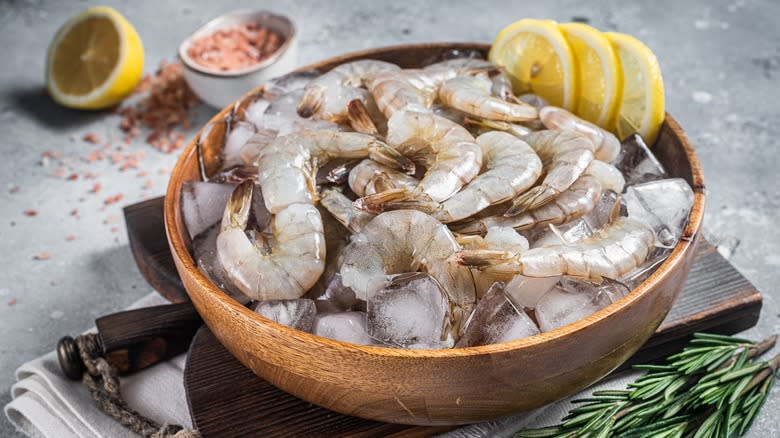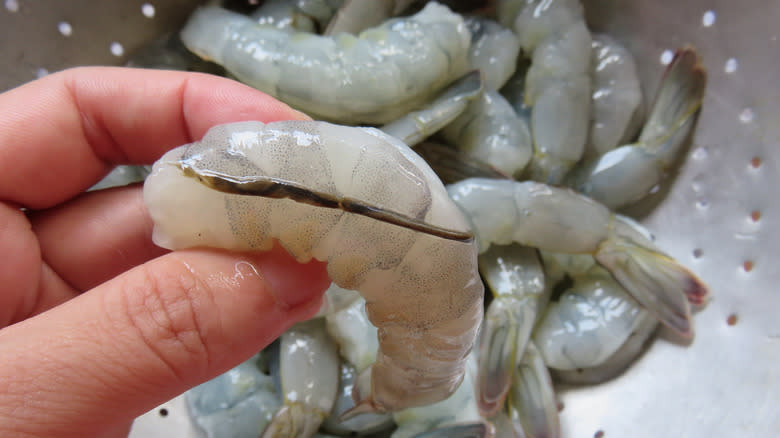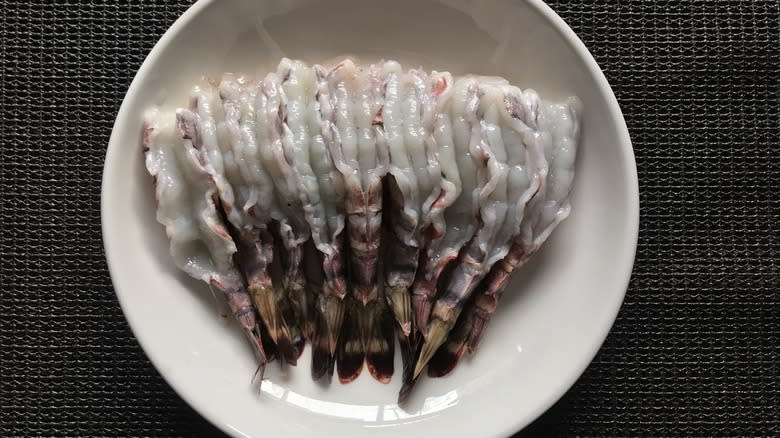Why You Need To Be Careful Deveining Frozen Shrimp

If you've ever picked up a bag of frozen shrimp from the grocery store, you've probably found these crustaceans already beheaded, shelled, and deveined. But you can save yourself some money if you buy whole frozen shrimp; you'll just need a little elbow grease. It's important to let your shrimp thaw out before you prep them, though -- especially when it comes to deveining. The shape of shrimp can make for an unwieldy deveining experience if not properly thawed ahead of time.
There are several things you'll want to know when cooking shrimp. First, prep your shrimp properly; washing your shrimp is optional (since the shells come off anyway), and most of the bacteria is killed when cooked thoroughly. If you find yourself with whole shrimp, start by thawing and removing their heads; this will give better access for deveining. Thawing is crucial because you don't want to take a knife to a shrimpsicle. One wrong move and you could end up in the ER, rather than at the dinner table in front of a plate of shrimp scampi. Once the little guys are headless and unfrozen, you can peel the shrimp, legs and all.
Read more: 13 Tips To Make Your Shrimp Taste So Much Better
What Is A Shrimp Vein?

Now that the shrimp have been dismantled, all you should be left with is the meat and those little black lines that run down the middle of their bodies. If you've ever been curious about that black line, it has a few names, including the dorsal tract or sand vein -- nothing that sounds very delicious. Unfortunately, the dorsal tract is what you might think it is: a shrimp's poop shoot. While the dorsal tract is not unsafe to eat, it does have an unpleasant texture, and conceptually, it's pretty unappetizing.
Once the shrimp is thawed, you'll notice that the meat may become delicate to handle. In fact, the act of deveining may also lead to mealy shrimp bits instead of a plump, whole shrimp. There are a few things to keep in mind when deveining these ocean bugs: First, make sure you have the proper knife. You'll want something small, like a sharp paring knife. The right knife will keep you from tearing the meat when you cut along the shrimp's back to pull the vein out. Secondly, develop a technique that is quick and accurate -- this isn't hard, it just takes a little practice. Don't fuss too much with the shrimp; try to remove the dorsal tract in one go, remembering that if you don't get all of it out, no harm will come to you.
Tips For Frozen Shrimp Prep

A trick for removing the vein is to place the shrimp flat on its side against a stable surface like your cutting board. Then, slice the shrimp down the length of its back perpendicular to the cutting board. This not only reduces the risk of injury to your hands, but also keeps the integrity of the shrimp meat. You definitely do not want to attempt deveining frozen shrimp; not only will you destroy the shrimp (if you can even cut through it to begin with), but you will have a heck of a time trying to pull a frozen dorsal vein out.
Remember, frozen shrimp are slippery and difficult to work with, and you don't want to wield a knife on a slippery surface. Factor in an extra 30 to 45 minutes to your prep time for thawing. Simply leave your bag of frozen crustaceans in a sink full of tap water, and they should be ready to go. You can, of course, get your shrimp pre-prepped, but you will save money on the whole ones and you'll have a broader variety to choose from at the store. Plus, you'll have the peace of mind of knowing that you thoroughly cleaned your shrimp of their sandy, excremental tubes.
Read the original article on Daily Meal.

